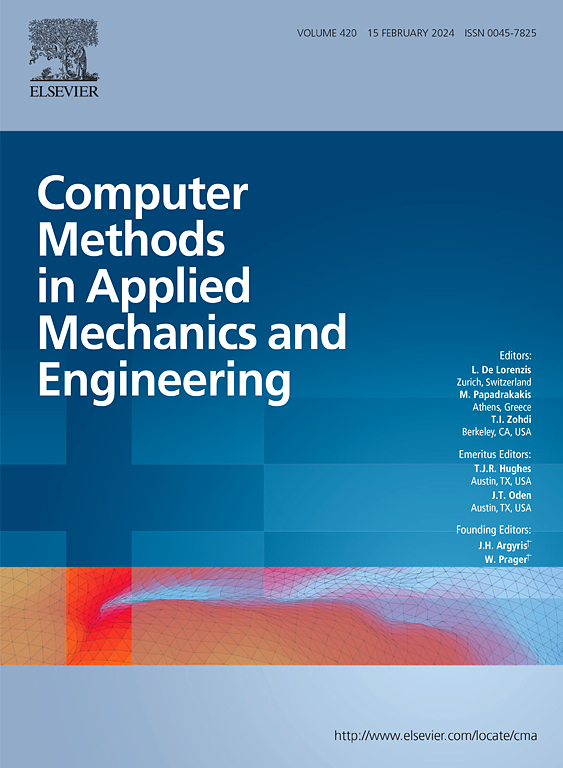基于多尺度虚功率方法的多尺度接触均匀化:计算实现与数值方面
IF 7.3
1区 工程技术
Q1 ENGINEERING, MULTIDISCIPLINARY
Computer Methods in Applied Mechanics and Engineering
Pub Date : 2025-07-09
DOI:10.1016/j.cma.2025.118146
引用次数: 0
摘要
在这项工作中,Couto Carneiro等人(2024)提出的多尺度接触模型(SS)和表面-体积(SV),衍生自多尺度虚拟功率方法,扩展了其原始数学公式。利用这些多尺度接触模型,开发了一种基于有限元的方案来实现异质接触界面的接触均质化。对支撑该框架的计算实现策略进行了全面分析,为其实际应用提供了有价值的见解。利用基于双砂浆的有限元离散化结合标准准静态或动态时间积分方案解决了潜在的平衡问题。特别注意确保牵引力的可接受性,这是通过规定满足特定关系的远程牵引力分布来实现的。这个过程被重新表述为一个非线性问题,通过一个具有两个迭代循环的全局求解算法来解决:一个外部循环用于牵引计算,一个内部循环用于有限元平衡解决。通过采用加速技术(如Broyden方法)和战略性地初始化这两个迭代过程,性能得到了显著提高。数值结果验证了解决方案的物理可接受性,证明了与现有文献的强烈一致性,并展示了模型处理涉及非线性材料和复杂界面相互作用的复杂应用的能力。这项工作突出了SS和SV方法在有效解决具有挑战性的多尺度接触问题方面的潜力。本文章由计算机程序翻译,如有差异,请以英文原文为准。
Multiscale contact homogenisation through the method of multiscale virtual power: Computational implementation and numerical aspects
In this work, the Surface-Surface (SS) and Surface-Volume (SV) multiscale contact models proposed by Couto Carneiro et al. (2024), derived from the Method of Multiscale Virtual Power, are extended beyond their original mathematical formulation. A finite element-based scheme is developed to enable the contact homogenisation of heterogeneous contact interfaces, leveraging these multiscale contact models. A comprehensive analysis of the computational implementation strategy underpinning the framework is conducted, providing valuable insights into its practical applications. The underlying equilibrium problems are solved using a dual mortar-based finite element discretisation combined with standard quasi-static or dynamic time integration schemes. Special attention is given to ensuring traction admissibility, which is achieved by prescribing remote traction distributions that satisfy specific relations with the solution fields. This process is reformulated as a nonlinear problem, tackled through a global solution algorithm with two iterative cycles: an outer loop for traction computation and an inner loop for finite element equilibrium resolution. Performance is significantly enhanced by employing acceleration techniques such as Broyden’s method and strategically initialising both iterative procedures. Numerical results validate the physical admissibility of the solutions, demonstrate strong agreement with existing literature, and showcase the models’ capability to handle complex applications involving nonlinear materials and intricate interface interactions. This work highlights the potential of the SS and SV approaches to address challenging multiscale contact problems effectively.
求助全文
通过发布文献求助,成功后即可免费获取论文全文。
去求助
来源期刊
CiteScore
12.70
自引率
15.30%
发文量
719
审稿时长
44 days
期刊介绍:
Computer Methods in Applied Mechanics and Engineering stands as a cornerstone in the realm of computational science and engineering. With a history spanning over five decades, the journal has been a key platform for disseminating papers on advanced mathematical modeling and numerical solutions. Interdisciplinary in nature, these contributions encompass mechanics, mathematics, computer science, and various scientific disciplines. The journal welcomes a broad range of computational methods addressing the simulation, analysis, and design of complex physical problems, making it a vital resource for researchers in the field.

 求助内容:
求助内容: 应助结果提醒方式:
应助结果提醒方式:


